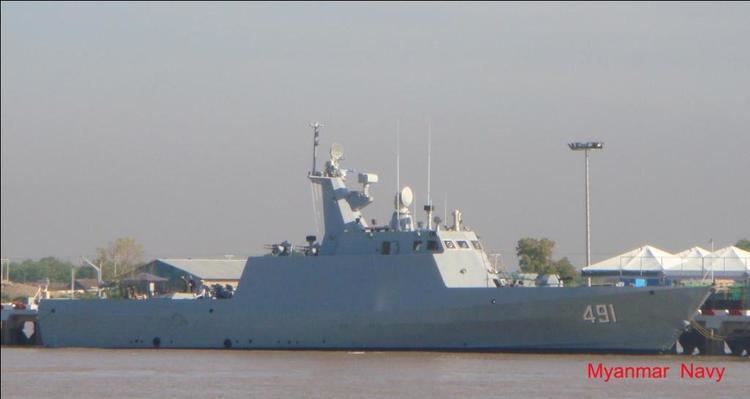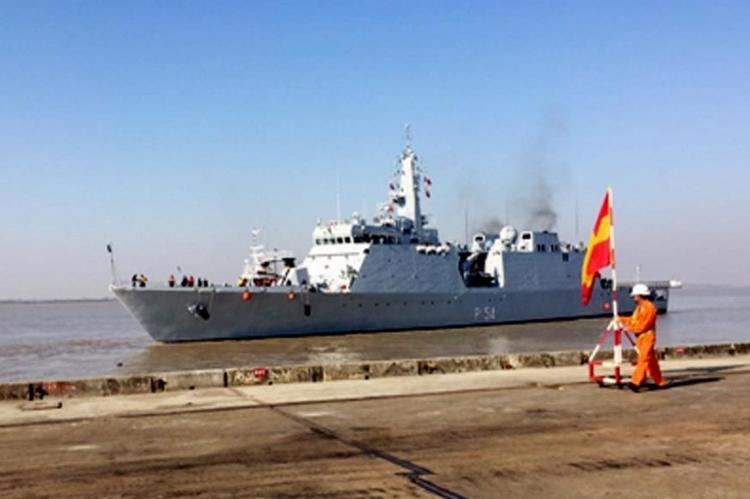Country Myanmar Size 19,000 personnel Part of Tatmadaw | Type Green-water Navy Nickname(s) Tatmadaw Yay Branch Navy | |
 | ||
Active 24 December 1947 – present Minister of Defence Lieutenant General Sein Win Similar | ||
The Myanmar Navy (Burmese: တပ်မတော် (ရေ); [taʔmədɔ̀ jè]) is the naval branch of the armed forces of Myanmar with 19,000 men and women. The Myanmar Navy currently operates more than 122 vessels. Before 1988, the Myanmar Navy was small and its role in the many counterinsurgency operations was much less conspicuous than those of the army and air force. Yet the navy has always been, and remains, an important factor in Myanmar's security and it was dramatically expanded in recent years to an external threat defence role in Myanmar's territorial waters.
Contents
- Pre independence
- Founding and the Second World War
- Burmese independence
- 1950s
- 1960s
- 1970s
- 1990s
- May 2008 Cyclone Nargis
- Attacks on Thai fishers and civilians
- December 2016 Bay of Bengal shooting incident
- Former and current Commanders in Chief since independence
- Frigates
- Corvettes and FAC stealth
- Administrative and support units
- Naval regional commands and bases
- Naval infantry
- Naval base air defence force
- Naval aviation
- References

Pre-independence
The naval arm of the Royal Armed Forces consisted mainly of shallow draft river boats. Its primary missions were to control the Irrawaddy River, and to protect the ships carrying the army to the front. The major war boats carried up to 30 musketeers and were armed with 6- or 12-pounder cannon. By the mid-18th century, the navy had acquired a few seafaring ships, manned by European and foreign sailors, that were used to transport the troops in Siamese and Arakanese campaigns.

The Arakanese and the Mon, from maritime regions, maintained more seaworthy flotillas than the inland riverborne "navy" of the Royal Burmese Army. The Arakanese in particular fielded a formidable seagoing navy that terrorised the coasts of Bay of Bengal during the 15th and 17th centuries.
Founding and the Second World War

The Myanmar Navy was formed as the Navy of Burma in 1940 and, although very small, played an active part in Allied operations against the Japanese during the Second World War.
Burmese independence

In December 1947, the Union of Burma Navy was formed with 700 men. The fleet initially consisted of a small but diverse collection of ships transferred from the Royal Navy under the arrangements made for Burma's independence in January 1948. It included the UBS Mayu, an ex-Royal Navy River-class frigate, and four Landing Craft Gun (Medium). Armed with two 25-pounder (88 mm) guns and two 2-pounder (44 mm) guns, these landing craft were used as support gunboats.
1950s

In 1950 and 1951, the United States provided 10 coast guard cutters (CGC) under the Mutual Defense Assistance Program (MDAP). The Myanmar Navy played an important part in the government's fight against the ethnic and ideological insurgent groups which threatened the Union Government in its early days. The Myanmar Navy performed both defensive and offensive roles, protecting convoys, carrying supplies, ferrying troops and giving much-needed fire support. It was instrumental in relieving the port city of Moulmein, which was captured by Karen insurgents in 1948, and the Irrawaddy Delta town of Bassein. Although one armed patrol boat defected to the Karen insurgents, throughout the turbulent years of post independence in Myanmar, the navy was largely unopposed and maintained control over Myanmar's crucial inland waterways.
In 1956 and 1957, the Myanmar government acquired five 50-long-ton (51 t) Saunders-Roe Dark-class convertible motor torpedo/motor gunboats, followed by an 1,040-long-ton (1,060 t) Algerine-class minesweeper in 1958 from the United Kingdom. In the late-1950s and early-1960s, the United States sold the Myanmar Navy six PGM type coastal patrol crafts and seven CGC type patrol boats. In the mid-1960s, the Myanmar Navy took delivery of ex-US Navy 640-long-ton (650 t) PCE-827 class corvette and a 650-long-ton (660 t) Admirable-class minesweeper, both of which were commissioned in the mid-1940s. In 1978, the United States provided the Myanmar Navy with six small river patrol crafts. In 1958, Myanmar's Navy took delivery of 10 Y-301-class river gunboats from Yugoslavia, followed by 25 smaller Michao-class patrol craft.
1960s
Efforts were made to produce locally made naval vessels with assistance from Yugoslavia. In 1960, the Myanmar Navy commissioned two 400-long-ton (410 t) Nawarat-class corvettes. Their armaments include 25-pounder field gun and 40 mm Bofors anti-aircraft gun. Myanmar shipyards also built a number of smaller patrol craft and a number of landing craft. Landing craft and auxiliary ships are usually armed with Oerlikon 20 mm cannons, 40 mm Bofors anti-aircraft guns and heavy machine guns.
1970s
Although the Myanmar Navy expanded rapidly during the 1950s and 1960s, the navy was unable to keep pace with loss or deterioration of older vessels in the 1970s until naval replacement program was initiated by BSPP Government in 1979. In 1980, the Myanmar Navy acquired six Carpentaria-class inshore patrol boats from Australia followed by three 128-ton Swift type coastal patrol boats from Singapore and three 385-ton Ospery-class offshore patrol vessels built in Denmark. The Ospery and Swift-class boats have a range of 4,500 and 1,800 miles (7,200 and 2,900 km) respectively and were armed with Oerlikon 20 mm cannons and 40 mm Bofors anti-aircraft guns. In the early years of the 1980s, Myanmar shipyards built three 128-ton PGM type patrol boats based upon US PGM-class patrol boats. Each boat was armed with two 40 mm Bofors anti-aircraft guns and two 12.7 mm heavy machine guns.
1990s
The Myanmar Navy purchased six missile escort boats and 10 submarine chasers from China. Since 1998, the navy has built two 77 m (252 ft 7 in) Anawrahta-class corvettes (771 and 772) and four fast attack craft (551-554).
May 2008 Cyclone Nargis
As many as 25 Burmese naval ships may have been sunk in the storm caused by Cyclone Nargis in May 2008, while an unknown number of naval personnel and their family members were killed or are listed as missing. The Network for Democracy and Development in Thailand reported that 30 officers and 250 Burmese naval personnel were declared missing, while 25 vessels were destroyed by the cyclone in three naval regional command centres: Panmawaddy Regional Command on Hainggyi Island; Irrawaddy Regional Command; and Danyawaddy Regional Command in Sittwe in Arakan State.
Attacks on Thai fishers and civilians
In May 1998, Colonel Zaw Min, landed on Christie Island and found 59 people gathering wood and bamboo in violation of Burmese law. The order came down from General Than Shwe that they were to be "eliminated" and they were all subsequently murdered.
A few days later, members of the Burmese Navy captured a Thai fishing boat that had strayed close to Christie Island. The 22 fishermen on board were shot and buried on the island.
December 2016 Bay of Bengal shooting incident
In December 2016, Bangladesh' border guard accused the Myanmar Navy of firing on four Bangladeshi fishermen in a trawler on the Bay of Bengal, leading to a formal protest.
Former and current Commanders-in-Chief since independence
Frigates
The Myanmar Navy started its modernisation program in 2001 in an attempt to replace older ships and equipment. In 2012, the navy took delivery of two Type 053H1 class frigates from China. These two ships were upgraded extensively. Upgrades included the replacing of HY 2 anti ship missiles by C-802 missiles and installing new sensors. The first indigenous frigate, the Aung Zeya entered service in 2011 and took part in a joint exercise with Indian Navy ships off Visakhapatnam in early-2013. A second ship, Kyan Sittha entered service in 2012 and is the navy's first stealth frigate. The navy plans to build six indigenous frigates; combining Russian, Indian, Chinese, and Western weapons systems. These ships are equipped with Kh-35E anti-ship missiles, OTO Melara 76 mm Super Rapid Cannons, AK-630 6-barrel 30mm close-in weapon system (CIWS) and Chinese ASW rockets and torpedoes. Radars and electronic systems are mainly from Bharat Electronics of India. Myanmar acquired surface-to-air missiles and anti-ship missiles from China for its newly built frigates and OPVs. Myanmar Navy Shipyard which was acquired from China in late-1990s is one of the most modern shipyards in the region. Many Myanmar naval engineers underwent shipbuilding training in China and Russia.
Corvettes and FAC (stealth)
In early-2011, two corvettes, 771 and 772, were upgraded to by installing C-802 missiles, SAMs, sonar, RBU 1200 ASW rockets, and new surface and air search radars. The most significant development was the launching of two new FAC (stealth) (pennant number P 491) which is 49 meters long and armed with 4 x C 802 missiles and a single AK 630 CIWS.
Twenty 45-meter class FACs (guns and missiles) are the backbone of the navy, but these ships are too small for new weapons and electronic systems. This is the main reason for initiating the 49 meter class FAC (stealth). Older Hainan class FAC (submarine chaser) will be degraded to Category B reserve by 2016.
Administrative and support units
Naval regional commands and bases
Naval infantry
The Myanmar Navy formed a naval infantry battalion of 800 men in 1964, and a second battalion in 1967. Third and fourth battalions may have also been raised. They battalions traditionally are deployed mainly in the Arakan, Tenasserim, and Irrawaddy delta coastal regions primarily to assist in the army's counter-insurgency operations.
Naval base air defence force
Myanmar Naval air defence forces use Bofors 40mm & ZPU-2 AAA for naval bases.
Naval aviation
The Myanmar Navy formed a naval aviation unit in 2014. Current inventory of the naval aviation fleets involve:
